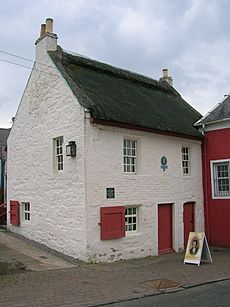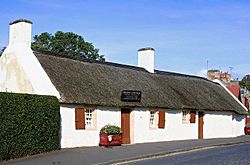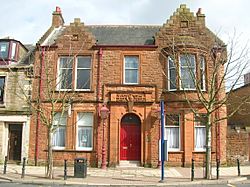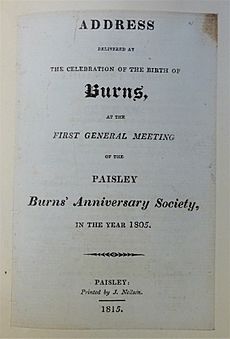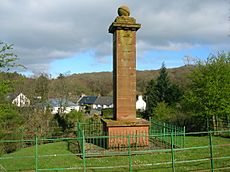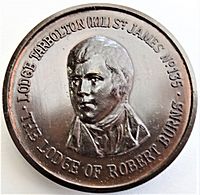Burns Clubs facts for kids
Burns Clubs are groups found all over the world. Their main goal is to remember and celebrate the famous Scottish poet, Robert Burns. They also encourage people to love his writings and learn about the Scots language and literature. Many clubs focus on helping young people get interested in Burns through poetry, singing, and other fun competitions.
In the past, most Burns Clubs were only for men, like the original Tarbolton 'Batchelor's Club'. But today, most clubs welcome women as members too. There are even clubs specifically for women, like the 'Irvine Lasses' club, which started in 1975.
Some Burns Clubs have special collections of Burns's original writings, old items, or souvenirs. For example, the Irvine Burns Club has the only surviving handwritten pages from his famous book, "Poems, Chiefly in the Scottish Dialect," which was printed in 1786. Many clubs also have libraries filled with books about Burns, other Scottish poets, history, and culture. The Bridgeton Burns Club in Glasgow is one of the largest, with about 750 members.
Clubs often hold ceremonies to lay wreaths. These events remember important dates like Burns's birthday and the day he passed away. They also celebrate other big moments in his life, such as when his first book was published.
Many clubs are part of a larger organization called the Robert Burns World Federation (RBWF). This group was formed in 1885 in Kilmarnock. There are also local groups, like the Ayrshire Association of Burns Clubs. A key tradition for most Burns Clubs is their annual celebration supper. These suppers happen around January 25th, which is the poet's birthday.
Most Burns Clubs are open to anyone who wants to join. However, some clubs are by invitation only, often because their meeting places are small. Examples include the Burns Club Atlanta and the Paisley Burns Club. Clubs are usually run by a committee, with a President or Chairman leading for one or two years. Many clubs have special chains of office, which are often engraved with the names of past leaders.
While most clubs rent places for their meetings, a few own their own buildings. These include the Irvine Burns Club, the Dundee Burns Club, and the Burns Club of Atlanta.
Contents
- Club Names
- Club History
- Oldest Clubs
- Alexandria Burns Club
- Burns Club of Atlanta
- Dalry Burns Club
- United Burns Club of Dunfermline
- Calgary Burns Club
- Edinburgh Burns Supper Club
- Greenock Burns Club
- Burns Howff Club of Dumfries
- Irvine Burns Club
- Kilmarnock Number 'O' Burns Club
- Burns Club of London - Number 1
- Paisley Burns Club
- Dundee Burns Club
- Partick Burns Club
- Winnipeg Robert Burns Club
- Club Activities
- Links with Freemasons
- See also
Club Names
Most clubs are named after the city, town, or area where they are located. Some clubs add a Burns-related word to their name, like "Cronies" or "Jolly Beggars." The Alamo Burns Club got its name from the inn where its first Burns Supper was held.
Club History
The very first Burns supper happened around 1801. Within ten years, many annual celebrations of Burns's life and works were taking place. By 2004, the Robert Burns World Federation had 400 clubs connected to it, with about 60,000 members in total.
Oldest Clubs
The Greenock Burns Club is known as the 'Mother Club'. It started in 1801 and has held celebrations every year since then. The Irvine Burns Club has also been active without a break since it began on June 2, 1826. Five of its twelve founding members knew Robert Burns personally. The Paisley Burns Club, founded in 1805, had a break from 1836 to 1874.
The Bridgeton Burns Club, started in Glasgow in 1870, grew very quickly. It is now a charity that runs school competitions. With over 600 people attending its annual dinner, it is likely the largest Burns Club in the world.
Even though the Burns Club of London is listed as No. 1 by the Robert Burns World Federation, the Kilmarnock Burns Club was actually recorded first as '0'.
Alexandria Burns Club
The Alexandria Burns' Club was formed in 1884. It was officially recognized by the Federation in 1885 as No. 2. The club holds an annual St Andrew's night celebration. Its main event is the annual supper, which up to 150 people attend each year.
Burns Club of Atlanta
This club officially started in 1896. It is a private social club that celebrates the works of Robert Burns. The club holds monthly meetings and an annual Burns Supper on Burns's birthday. These events have happened every year since 1898. The club meets in the Atlanta Burns Cottage, which is a copy of Robert Burns's birthplace in Alloway. It was built in 1909.
Dalry Burns Club
The Dalry Burns Club began in 1825. It has one of the longest continuous records of Burns Suppers, second only to Greenock. Other clubs started earlier, but none have Dalry's unbroken record of annual celebrations. The club is 'Number 35' on the Robert Burns World Federation list.
United Burns Club of Dunfermline
The first Burns Club in Dunfermline was the 'Haggis Club', formed in 1812. It lasted until 1820. The Dunfermline Burns Club started in 1820. Then, in 1847, it joined with the Junior Haggis Club to become the United Burns Club of Dunfermline.
Calgary Burns Club
The Calgary Burns Club was founded in 1974. It officially received its charter in 1976. The idea for the club came from a Burns Supper held in a home in Calgary, Canada, in 1964. The club holds the memory of Robert Burns and the friendship that comes from it as very important. It also helps promote Scottish literature, art, and music in the community.
Edinburgh Burns Supper Club
The Edinburgh Burns Supper Club was formed in 1848 by George Thomson, a friend and publisher of Burns. It is No. 22 on the Robert Burns World Federation list. Famous writers like Arthur Conan Doyle attended its dinners. The club stopped meeting in 1986 but started again in 2007.
Greenock Burns Club
The first Burns Club, known as 'The Mother Club', started in Greenock on July 21, 1801. This was the fifth anniversary of Burns's death. The club is said to have held the first Burns supper on January 29, 1802. However, it was later discovered that Burns's correct birthday was January 25, 1759. Several club members knew Burns, including Richard Brown, his friend from Irvine. The club has held an annual celebration every year since it began.
Burns Howff Club of Dumfries
This club was formed in 1889. It joined the Robert Burns World Federation in 1899 as 'Number 112'. The club meets in the Globe Inn at Dumfries, which was Robert Burns's favorite pub, or 'Howff'. The club's membership is limited to 120 people because its room in the Globe Inn is small. It also has a large library of books about Burns and his time, along with many Burns souvenirs.
Irvine Burns Club
The Irvine Burns Club started in Milne's Inn and is now located in Wellwood House. It has been active without a break since June 2, 1826. The club had twelve founding members. Five of them knew Robert Burns, and two were close friends. The first club president was Dr John Mackenzie. He had been a doctor in Mauchline and attended Burns's dying father. David Sillar, the first vice-president, was a friend of Burns since they were teenagers.
Kilmarnock Number 'O' Burns Club
This club started in 1808. It had several periods when it was not active, including during the World Wars. When the Robert Burns World Federation was set up in 1885, the Burns Club of London became 'Number 1'. This led to the Kilmarnock Burns Club being given the 'Number 0' title.
Burns Club of London - Number 1
The Burns Club of London was founded in 1868. Its founder, Colin Rae Brown, was also involved in setting up the Robert Burns World Federation. Because of this, the club became 'Number 1' on the Federation's list. The club meets regularly and lays a wreath at the Burns monument in London every January 25th.
Paisley Burns Club
This club was founded in 1805. It claims to be the world's oldest officially formed Burns Club. It meets monthly in a cottage once owned by Robert Tannahill, a local poet. The club owns its building. Membership is limited to 40 men. The club was not active from 1836 to 1874.
Dundee Burns Club
The Dundee Burns Club was founded in 1860. From 1877, the club worked to put up John Steell's statue of Robert Burns in Dundee's Albert Square. A special silk banner made for the statue's unveiling in 1880 is now kept at the McManus Gallery. The club even has a pipe reel dance tune named after it, "The Dundee Burns Club."
Partick Burns Club
The Partick Burns Club started in 1885. It has met to honor Robert Burns every January since then, except for some years during the First and Second World Wars. The club was founded by local business people and members of the Partick town council. Its annual supper usually has about 130 attendees, ranging in age from teenagers to seniors.
Winnipeg Robert Burns Club
The Winnipeg Robert Burns Club was founded in 1907. It joined the Burns Federation in 1911 as #197. It claims to be the "oldest continuously existing federated Burns Club outside the United Kingdom." The club put up a statue of Robert Burns, a copy of the George Lawson statue in Ayr, at the Manitoba Legislature in 1936. It holds its Burns Supper every January 25th.
Club Activities
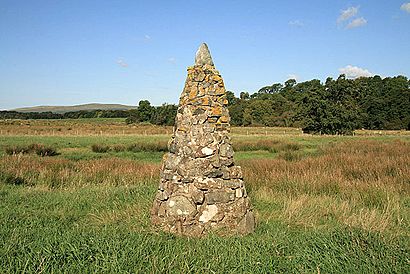
Besides Burns suppers, clubs are involved in school and club competitions for young people. They also have inter-club nights and other social events.
Local clubs and the Robert Burns World Federation also help take care of various places linked to Robert Burns. These include the 'Trysting Tree' from Burns's poem The Soldier's Return and the Highland Mary and Robert Burns Memorial.
Clubs also raise money for good causes, give talks, and do original research. They have special nights like Ladies or Jean Armour Nights, St Andrew's Nights, and Hallowe'en Nights. They also organize annual trips and take part in local events.
Every year, the Southern Scottish Counties Burns Association holds a service at the Brow Well. This service remembers Robert Burns, who passed away four days after visiting the Brow Well on July 21, 1796.
The 'Burns Chronicle', first published in 1891, keeps a record of clubs and their activities. It includes articles about Burns contributed by members.
Links with Freemasons
Robert Burns became a Freemason in 1781. He was elected "Depute Master" of Lodge St. James at age 25. In 1787, he was honored as the Poet Laureate of Lodge Canongate Kilwinning No. 2 in Edinburgh. When Burns moved to Dumfries, he joined Lodge St. Andrew in 1788. A strong connection to Freemasonry is a feature of many Burns Clubs.
See also
- Brow, Dumfries and Galloway
- Drukken Steps
- Ellisland Farm, Dumfries
- Friar's Carse
- Robert Burns and the Eglinton Estate
- Robert Burns' diamond point engravings
- Robert Burns World Federation


